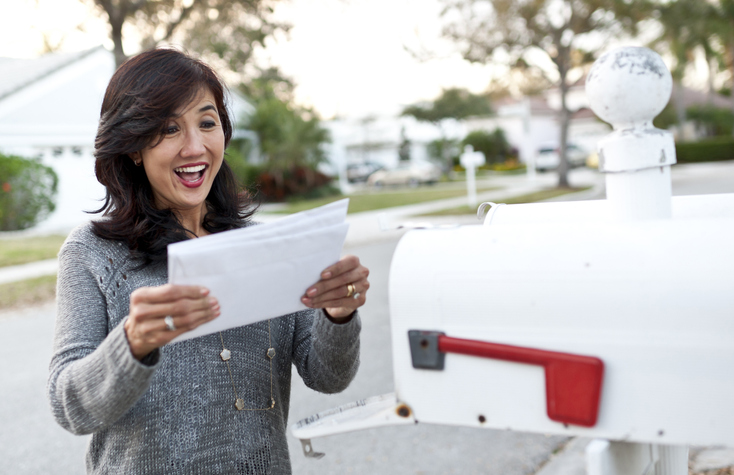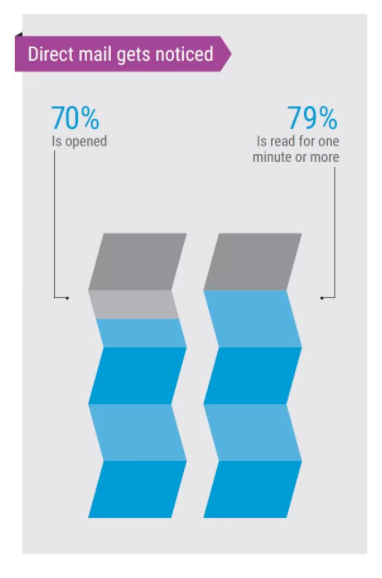
Good news for some of us old-school marketers… direct mail is back! Unless you’re a recent college grad, you probably grew up with direct mail, as did I. I don’t know exactly why, but DM holds a special place in my heart; and not just from creating it in my agency days, but from receiving it, too. There’s something about finding “stuff” in my mailbox, even if and when it’s not a personal letter, but an oversized postcard good for 20% off at my favorite retailer.
I think, and I could be wrong I suppose, that most people feel the same way that I do when it comes to getting mail. You know why? It shows commitment. Whether, as I said, a personal letter, a postcard, flyer, or a FSI (Free Standing Insert), the message with mail is that someone (or in many cases, some company), took the time, made the effort, and spent the money to reach out.
So, is DM back? Well, the facts seem to say so. At least according to Vox, and the Small Business Administration it is. “Direct Mail is Hot Again,” tells us why and how. “Print magazines are fading, more and more bills are paid online, and many brands have scaled back on printed catalogs, preferring to funnel resources into website upkeep and social media instead. Yet over the last few years, brands — including hot, digitally savvy, direct-to-consumer ones like Casper, Harry’s, Wayfair, Rover, Quip, Away, Handy, and Modcloth — have taken to targeting customers in the mail.”
 Why do these disruptive, online-first companies want to be our old school pen pals? The rise of young, digital brands spending money to mail us stuff speaks to the cyclical progress of shopping trends. A decade ago, companies looking to reach customers would often buy email addresses from third parties. They’d do giveaways and, if existing customers handed over their family and friends’ email addresses, they’d offer discounts too.
Why do these disruptive, online-first companies want to be our old school pen pals? The rise of young, digital brands spending money to mail us stuff speaks to the cyclical progress of shopping trends. A decade ago, companies looking to reach customers would often buy email addresses from third parties. They’d do giveaways and, if existing customers handed over their family and friends’ email addresses, they’d offer discounts too.
In “8 Reasons why Direct Mail is More Effective than Email, Xerox makes this case for direct mail: “The latest data makes a strong case for printed direct mail. Sure, social media and mobile marketing are on the rise. But that doesn’t mean that customers aren’t responding to direct mail or that this channel is losing its effectiveness.” Unlike email, direct mail doesn’t require an opt-in, which means you’re not hamstrung by a third-party email list, or the challenge or getting recipients to opt into your marketing messaging. Direct mail never goes to “spam.” Direct mail tends to stick around in places where it can be seen. Although you may think that people stand over the trash bin when going through their mail, that’s not the case in workplaces. Xerox says that a direct mail piece can hang around someone’s desk for weeks and, more often than not, is read more than once. Direct mail doesn’t need to compete with an inbox filled with hundreds of messages. Most importantly, direct mail appears to lend itself well to B2B messaging, such as financing. “Mailers," says Xerox, “can also include a wide variety of trust-building content not possible (or reasonable) to include in email. Plus, there are only so many things you can do to make email look more important; beyond writing a compelling subject line, for instance, there is not a whole lot. Direct mail offers options like kits, dimensional mail, and unique packaging options that, by their nature, get attention.”
Does DM work? It certainly does, according to this success story recently recounted in an ABA Bank Marketing article on direct mail best practices. “Consider this example from Liberty Bank attracting new movers to open deposits. Prospects were located in neighborhood settings outside of Chicago, two miles from each branch. A big challenge was conveying to millennials that a smaller bank like theirs could do just as much (and more) as the larger, bigger name banks. On the back of the postcard are printed ATM locations close to the resident’s home. Within four months, Liberty established dozens of new accounts and within five years, revenue from the new mover campaign is estimated at $90,000.”
Back to what I said earlier. It’s not just the information you convey. Recipients like me, whether conscious of it or not, appreciate the commitment that the sender made to put a DM package together. Give it a try. I bet that your recipients will feel the same way.
About Bank Marketing Center
Here at BankMarketingCenter.com, our goal is to help you with that vital, topical, and compelling communication with customers; messaging that will help you build trust, relationships, and revenue. In short, build your brand. To view our campaigns, both print and digital, visit BankMarketingCenter.com. Or, you can contact me directly by phone at 678-528-6688 or email at nreynolds@bankmarketingcenter.com.
As always, I would love to hear your thoughts on this subject.